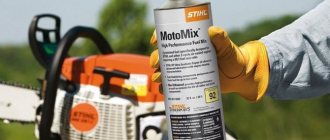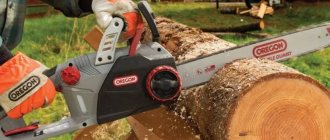Today, such a tool as a chainsaw honorably takes its rightful place in our work activities. After all, judge for yourself how you can do without it, for example, on a summer cottage, when you need to cut down a dry branch or prepare firewood for the winter? Today, there are a huge number of different models of this tool (see the rating of the best chainsaws), from simple ones for household needs to professional “giants” that are used to cut down huge trees. Yes, the choice is significant, and as they say: there is room to accelerate. But choosing and buying a tool is half the battle; you also need to know how to properly care for it. In this article you can find answers to questions regarding oil lubrication of the saw chain. The best lubricant manufacturers will be presented here, which ones are best to use, and generally what they are needed for. But let's take things in order. So let's get started.
Chainsaw chain lubrication system
To supply oil to lubricate the chainsaw chain, the tool uses a special pump, which delivers lubricant to the saw bar in a dosed manner, depending on the number of engine revolutions.
The system uses oil to lubricate the chainsaw chain, which has increased adhesive properties; this is necessary for uniform distribution of oil along the entire perimeter of the bar and retention on it even at high rotation speeds of the chain. Let's take a closer look at the oil supply system implemented in modern chainsaws.
Related Posts
Chainsaw
. What kind of oil is used to lubricate the chain?
Chainsaws. A popular tool for those who deal with numerous household chores. They can be used for different purposes. collect firewood, trim dry branches. But in order for the device to last as long as possible, it is necessary to take proper care of it by choosing the right different connections. A special role is played by chain saw oil, which is selected depending on the principles of the tool and its characteristics.
Lubrication system design
Depending on the brand of chainsaw, the parts of the lubrication system may vary slightly in design, but their total number and connection diagram remain the same.
The main components of the lubrication system are:
- an oil tank located, as a rule, in the engine crankcase.
- The filter element is installed in the tank.
- The oil line is a small diameter hose made of oil-resistant rubber.
- The heart of the system is the oil pump.
- The worm gear transmits force from the engine to the pump.
- The chainsaw tire can also be considered an element of the lubrication system, since it has special holes for supplying oil. By the way, the chain itself is involved in transporting oil and, accordingly, also has some elements designed specifically to provide lubrication.
Types and composition
The choice of specific oil depends on where and how the chainsaw operates. Mineral compounds are suitable for the summer and warm seasons. In other cases, it is better to use synthetic or semi-synthetic oils. If it is necessary to lubricate the chain, there is no need to use waste oils, which will clog the fuel system and then cause serious damage to the tool.
The chainsaw oil must be thoroughly cleaned to ensure that the lubricant is applied correctly and accurately. If you use poor-quality connections, there will be no contact between the saw elements and the bars, sparks will appear, and then the moving parts of the saw will wear out.
Principle of operation
The main unit of the system is the pump. The principle of its operation is as follows. As engine speed increases, a gear mounted on the main shaft drives the pump shaft through a worm gear. In turn, the rotation of the shaft creates a certain pressure in the oil line, which forces the oil to move along it towards the tire.
The end of the oil channel is located at the point of contact of the tire with the tool housing, where there is a longitudinal groove into which, when installing the tire, its oil channel falls.
The groove is necessary to ensure the supply of oil to the bar, regardless of the degree of tension of the chainsaw chain. Simply put, no matter what position the tire is in at the time of operation, oil will get onto it through the groove.
Next, the lubrication process includes a chain, on the links of which, depending on the chain model, there is either a groove or a hole through which the oil is dispersed throughout the tire. As engine speed increases, the oil flow rate also increases.
Some models of chainsaws are equipped with pumps that additionally have capacity adjustment, and if necessary, the amount of oil supplied by the lubrication system can be increased or decreased.
This function is quite convenient, because it allows you to save money and not waste extra oil.
Ravenol
Which chain lubrication oil should you choose? Many people note Ravenol brand compositions. Thus, Ravenol Saegekettenoel S 85 is a special mineral oil created in Germany from high quality base oil with the addition of various additives. It is suitable for saw chain lubrication and has good adhesive and lubricating properties. Thanks to special additives, the oil remains on the chain even at high saw speeds, and the chain itself becomes more reliable in operation. Provides oil and reliable corrosion protection even when operating under the most favorable conditions. By using this composition you can:
- reduce vibration of the saw chain;
- reliably protect it from corrosion;
- cool the circuit due to good thermal conductivity;
- quickly and cleanly cut all types of trees.
Lubrication system malfunctions and how to fix them
The main malfunctions of the oil supply system on a chainsaw can be divided into two main types: these are general malfunctions inherent in all chainsaws and individual ones, which may vary depending on the type of pump and worm gear installed on a particular model. Let's begin to understand the faults in order.
Operating a chainsaw without lubricating the chainsaw chain is prohibited. This has a detrimental effect on the bar, drive sprocket and chain, and can result in significant repair costs.
Signs of a malfunction of the lubrication system, checking its performance
- The chainsaw chain is dry and has a pale tint without shine.
- The chain stretches relatively quickly.
- The tire is very hot and may even partially melt the paint.
- The oil from the tank is practically not reduced.
- Reduced cutting efficiency on a sharp chain
All these signs indicate that the lubrication process is not proceeding properly. In order to check the oil supply to the lubrication system, you need to remove the side tire of the chainsaw and start it. Next, you need to slightly increase the speed while observing the end of the oil line. If oil comes in, most likely the amount is not enough for normal lubrication and you need to clean or replace the filter and, if possible, adjust the flow. If it does not, the problem is more serious and requires further diagnosis.
There is a way to check the oil supply without removing the tires. To do this, you need to point the end of the bar towards, for example, a freshly cut piece of wood from the side of the cut and increase the speed as much as possible, while trying to keep the end of the bar at a distance of no more than 10 cm from the block. If oil spots begin to appear on its surface, it means the oil is being supplied.
Troubleshooting
Once it has been determined that oil is not being supplied, further diagnosis is only possible if the oil system is completely removed. Of course, in some situations replacing the filter helps, but this is very rare.
Access to the oil pump of some models of saws is possible only after complete disassembly; therefore, without having the skills to repair gas-powered tools, it is better to entrust repairs to professionals.
Most common faults
- Broken oil hose. It can sometimes be detected by visual inspection. The problem is solved by replacing the faulty part.
- There is no thread on the oil pump shaft; replacing it will help.
- A defective thread on the pump drive gear can be similarly solved by installing a new part.
- Lack of main shaft corkscrew (relevant for some instrument models, for example, Homelite). You can fix it by installing a nail of a suitable diameter instead of the original corkscrew, cutting it to the required length.
- Blockage in the line. Can be removed by blowing with compressed air or mechanically, using a wire of a suitable diameter.
- Filter element clogged.
- The Stihl MS 180 tool, whose pump is not dismountable, often gets clogged. You can try to wash it in clean gasoline, if that doesn’t help, replace it.
- In Chinese chainsaws (Gypsy), it very often cuts off the grooves on the main gear, through which the force from the sprocket is transmitted to it.
Tags: choosing oil for lubricating a stihl chainsaw chain in winter
Comments 43
If you cut all day long, you can pour I-40 and other new ones. Well, what the heck - it stinks, then everything turns black, the oil pump can skip if it’s not filtered. Yes, and all the sawdust is in this mining, all of this is then absorbed into the ground.
If you cut several cubes for yourself, then buying 1-2 liters at 2-3 € per liter of good, proper oil is not such a big waste.
Specialist. Chain oil is mostly mineral, there are even biodegradable oils. It is sticky and stretches like snot. I recommend not saving. It also depends on the saw; on normal saws the pump turns only when the chain moves, and not constantly. You can also reduce the feed. The right oil is used correctly. On the Huska 550XP, one oil fill was enough for me for 1.5-2 gas fills. And at two gas stations you can cut quite a lot.
PS And the tire is killed by improper use, a dull or incorrectly sharpened chain. And only new chains stretch, and then only a little, if the sprocket is not dead.
We use m8v, popularly “eight” or “autol”. The work is seasonal, from early spring to late autumn. Tires and chains wear no more than with the recommended oil.
I fully support it, I used it before, compared the price when purchasing, at this I-40a gas station the price (13.15 Belarusian rubles) was the cheapest, although in online stores the price of M8B and I-40a is almost the same
Once I suggested to a friend to use a gl-5 transmission to lubricate the chain. I spent the summer building a house.
As a result, the tests were successful. He said that the chain began to stretch much less, and he liked the saw’s performance.
The only downside, as he said, is that it stinks more during work)
Now only his is pouring.
I have a Shtil 180 and it’s about 20 years old, and even the original piston one, and it works in the spring and fall, God willing, and I use the exhaust all the time, but I try to take the exhaust from gasoline, it’s much cleaner.
Any clean (new, NOT used) industrial or motor oil will do, I rely on my 10 years of experience working with STIHL saws. The viscosity should be poured depending on the season. For example, in winter you can fill in a very viscous one, only so that the oil is warm. There is no need to pour oil, the oil pump doesn’t like it.
I agree, that’s what I bought, it’s clean, new, it doesn’t feel very viscous, when looking at the counter, all the motor and transmission ones were more expensive. I didn’t take the heat into account; in winter I’ll store it in a warm pantry and not in the garage. Thank you.
Why didn’t you like working with an internal combustion engine?
What oil should I use?
It is widely believed that high-quality branded chain saw oil should only be used in the gasoline-oil mixture of the engine. Nevertheless, choosing a lubricating oil is not a difficult matter. Anything will do, as long as it goes where it needs to go.
But applying lube to the chain is half the battle. It needs to stay on the metal and remain on the lower edge, which is used to saw the wood. For this purpose, substances with increased adhesion are used, that is, the ability to stick to a surface and stay on it. Oil with weak adhesion will fly off the rapidly rotating chain, splashing everything around to no avail. Of course, some part will remain, but it is unknown whether this will be enough to prevent the circuit from overheating during intensive work.
Important! When using a chainsaw all-season, you need to take into account the dependence of the oil supply conditions on the time of year and air temperature.
Mineral materials that provide chain and bar lubrication at above-zero temperatures crystallize and thicken in the cold. This leads to the fact that lubricant will be supplied with difficulty and the load on the oil pump will increase. Its service life is reduced and it may fail prematurely. In winter, you need to choose synthetic materials with special additives that provide reliable lubrication in frosts down to -40 ℃. In mild frosts and temperatures around zero, semi-synthetics are used.
Estimates of the use of different oils for lubricating chainsaws boil down to the fact that the wrong choice can increase the load on the engine by up to 10%. The service life of the chain and saw bar itself is further reduced.
Due to the recent emphasis on the environment, branded oil products are increasingly being made from biodegradable substances. But during long-term operation, the consumption of chain lube can be measured in liters. And for people who care about nature, this will be another reason to choose an environmentally friendly product. If you care what your area is splashed with and what marks remain on the wood after cutting.
How to choose?
Each chainsaw has a two-stroke carburetor engine and two tanks: one filled with gasoline, the second. oil. When choosing a lubricant composition, zoning plays an important role. it should be minimal. Another important indicator is resistance to low temperatures: the oil should not freeze at extreme temperatures, which will ensure the quality of the entire tool.
For lubrication, it is recommended to use adhesive chain oil containing special substances that allow the composition to adhere well to the chain. High-quality oil will remain on the chain as it rotates, and the chain itself will be more reliable in operation.
When and how to fill
It’s clear where to add chain oil. There is a separate container for this. In most chainsaws, the size of this container is calculated taking into account the volume of the saw's gas tank. When both tanks are filled to capacity, they empty at approximately the same time. Therefore, it is recommended to fill the full volume of the oil tank at the same time as filling the fuel tank. Then you won’t have to be distracted by topping up twice.
Before starting work, it is useful to check whether oil will flow to the chain. To do this, just point the end of the tire onto a flat surface. Some of the grease will fly off the edge of the tire. Droplets falling on the surface indicate normal operation of the system.
At high negative temperatures, summer oil thickens and its lubricity deteriorates. Therefore, it is worth using brands designed for winter conditions. If this is not possible, then it is worth spending time diluting the existing oil to reduce its thickness. It is best to dilute with kerosene in a ratio of 1 to 4.
Some models provide adjustment of the feed rate in the lubrication system. It is useful for adjustments in case of changing the type of lubricant.
Note! You cannot fill the tank with a mixture of oils of different types - mineral and synthetic.
If you run out of oil from one manufacturer, and the same type is available, but from another company, then mixing them is allowed, subject to immediate use. You should not leave such a mixture for a long time.
Divinol
This brand offers high quality chain lube that has good adhesive and lubrication properties, so that the lubrication is done efficiently and the hinges and chain loops are reliably protected from wear. The optimal combination of viscosity and temperature characteristics guarantees that this oil can be used at any time of the year and at any temperature.
Divinol offers a variety of oils for chainsaws. What's the use of them? Zweitaktoel FF pays attention to economical consumption, connection to any fuel, prevention of aging of the fuel mixture and excellent corrosion protection. In addition, this oil can be used at any temperature. Divinol Kettenol and Divinol Kettenol Bio can be used to lubricate chainsaws and chainsaws. With these connections, chain links and joints can be reliably protected from wear, while ensuring economical oil consumption. High-quality organic oils of this brand provide excellent lubricating and adhesive properties, so their use is not only simple, but also environmentally safe.
Sprocket Lubricant
At the end of the chainsaw bar there is a driven sprocket, which ensures rotation of the chain. It also needs to be lubricated periodically. For this purpose, thick materials are used. You can use STIHL universal lubricant. Domestic lithol-based lubricants are also suitable. There is a special hole on the tire for lubricating the sprocket. You need to pump lubricant into it using a grease nipple or syringe.
Please note that if you frequently work with the toe of the tire, for example, when making grooves, the load on the sprocket increases and it needs to be lubricated more often.
Main manufacturers
Leading manufacturers of chainsaws produce consumables and lubricants for them, including those specifically for chains and tires. All other things being equal, preference should be given to the products of the manufacturer of the chainsaw itself. But the quality of the best brands is such that using lubricants from another manufacturer will not have a negative impact on performance.
The most famous brands are the German company STIHL, the Swedish Husqvarna and the Japanese Makita. They provide a fairly wide selection of adhesive oils, including the following:
- mineral Stihl ForestPlus is designed to work at temperatures down to -15 ℃. Standard packaging – 1 and 5 l. For long-term work, it has recently been produced in 20-liter containers;
- The highly environmentally friendly Stihl BioPlus is produced on a plant basis. Once in the soil, it quickly decomposes without polluting it. The operating temperature is also up to -15℃. Packaging – 1 and 3 l;
- For low temperatures, semi-synthetic Stihl SynthPlus is suitable, operating down to -25 °.
- Eco-friendly, biodegradable Bio and Bio Advanced. Presented as a universal all-season oil. Bio Advanced option - improved oxidation resistance and up to 10% better lubricating properties;
- Makita. Biotop oil;
- Champion adhesive oil.
Among the Russian brands specifically for chains there is “ZUBR ZMPM-M”. There are also other, less well-known manufacturers whose lubricating oil is noticeably lower in price.
Oregon
What kind of oil is used to lubricate chains and how to choose one so that it can be used at any time of the year? The Oregon brand offers connections that are suitable for all types of tools. Viscosity stability guarantees that the oil is suitable for use at any time of the year. The composition includes purified mineral oils to which additives are added. The peculiarity of Oregon compounds is that they are made on the basis of high molecular weight compounds. The distinctive features of the oil are:
- protection of the guide bar and chain from overheating;
- vibration reduction;
- preventing corrosion due to the formation of an oil film.
Thanks to special adhesive additives, this oil acquires greater viscosity and viscosity, so even at high speeds it will not splash and remain on the chain and bar. Regular use of oil can reduce the load on the cutting set and, in general, the entire mechanism of the chainsaw. Special additives can reduce the energy consumption of the saw, which increases the efficiency of the sawing process. The main thing is that when using these tools, deposited deposits are not formed.
How to replace expensive oil
The disadvantage of special branded chain lubricants is their high price. Buying a liter of another expensive oil is not burdensome. And if there is work to be done that requires several liters, or even tens of liters, thoughts about saving will probably arise. The main thing is not to go to extremes when considering options. You can save on oil to such an extent that you will have to change the chain several times, or even the tire itself or the oil pump.
There are three replacement options. Firstly, you can use specialized products from little-known manufacturers to lubricate the chain. But we still need to look for such oils. In addition, there is a risk of stumbling upon a low-quality product.
Application of oils for automobile engines. They can be used as a temporary replacement, but they cannot boast of high adhesion, so the quality of their work will be clearly worse than special ones. For this reason, it is not recommended to use spindle and diesel oils - the worst in terms of adhesion.
And we definitely need to talk about one more option - working out. This is the name of oil that has spent its life in the engine and is drained from it when replaced.
In fact, this is not an option at all. Metal particles are always present in the waste. And if they may not damage the chain itself, then they certainly will not damage the oil pump and the entire lubrication system. On forums on the Internet you can find a “killer” argument in favor of testing - that the Soviet chainsaw “Druzhba” did not have chain lubrication at all and worked. So you can pour whatever you want - and it will do. Well, “Shtil” will also work with a working off or even with a non-lubricated chain. The question is how long it will work and how many chains will have to be replaced during this period.
A warning to those whose chainsaw is under warranty. Warranty workshop technicians are able to identify cases of poor-quality chain lubrication. Especially when using mining. Repairs under warranty will be rejected immediately.
Oil does not flow to the chain, what are the reasons?
It is not always possible during operation to immediately see that oil is not supplied to the chainsaw chain. Signs of lack of lubrication:
- the level in the tank does not decrease;
- cutting is difficult, accompanied by the smell of burnt wood;
- Oil droplets do not fly off the tip of the chainsaw bar.
Having discovered a malfunction in the oil system, you need to determine its cause. There are a few of them - clogging, a broken hose or a malfunction of the oil pump.
Most often, the oil supply channel becomes clogged with dirt and sawdust. Blowing with air or cleaning with a thin wire is enough to eliminate the problem. The oil tank has its own internal filter. When using normal oil, it is unlikely that it will become clogged, but when it is filled with oil, it is quite possible. Will have to clean it up.
The oil hose may be damaged or completely broken. You can temporarily seal the damaged area, but it will be safer to replace it with a new one.
And the most serious problem is a breakdown of the oil pump. The reasons may be different - the teeth of the worm gear have worn out, the plunger has jammed, etc. Removing the pump and replacing the damaged part yourself will not be easy. It is safer and easier to contact a service center.











